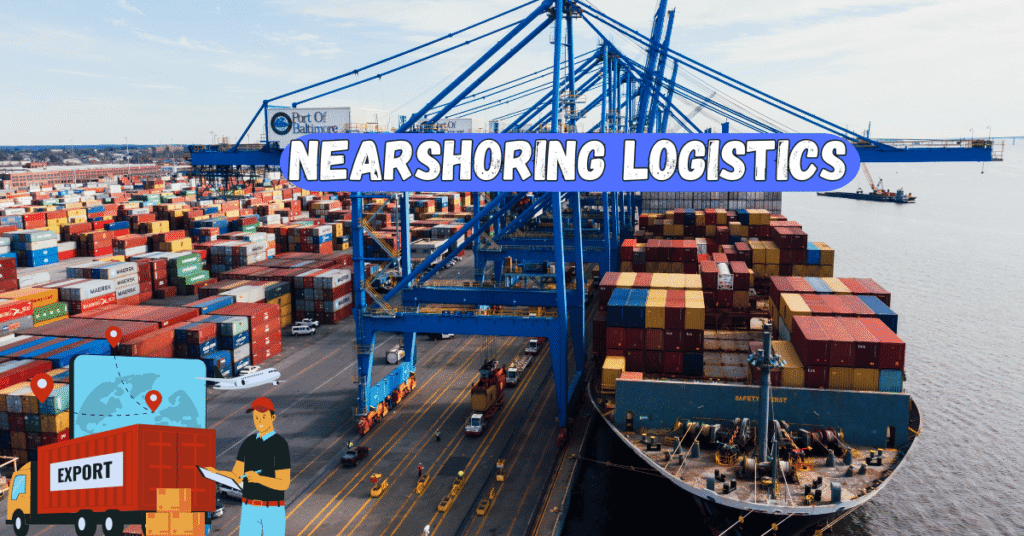Introduction
In the fast-paced global trading environment, all forms of businesses will surely assess and reevaluate their supply chain management tactics. Traditional offshore models have changed thinking within organizations; other factors include the pandemic, geopolitical tensions that characterize relationships between countries, and rising transportation costs. Recently, the trend has been that more and more organizations are now into nearshore logistics: relocation of production and logistics into fundamental markets, as near as possible, to reduce risks, accelerate time-to-market, and save logistics costs. This article discusses the advantages, challenges, and actual instances of nearshoring logistics.
Defining Nearshoring Logistics
Nearshoring logistics involves relocating business operations, from manufacturing to distribution, to nearby countries alongthe coast. It means bringing operations home, but it is still cost-competitive compared to other far-off locations.
For example, an American manufacturer might move production from China to Mexico nowadays; likewise, a German company moving from Vietnam might go to Poland. The sweet spot is the agile-responsive supply chain at a competitive cost.
Reasons for Growing Interest in Nearshoring Logistics
Here are some of the factors illustrating the growing interest in nearshoring logistics:
Supply Chain Disruptions
The COVID-19 pandemic showed just how vulnerable the global supply chains are today. By the time the lockdowns came, ports were closed, and there was a shortage of containers, leading to delays with increasingly sweeter prices. It’s just in-your-face proof that it needs to be smaller and more controllable.
Rising Labor Costs in Asia
At one time, wages were not a factor in certain low-cost countries such as China. But then wages in the low-cost countries escalated, causing the edge with offshore benefits to erode. To find cheaper labour close by, there’s a possibility.
Tariffs and Trade Policies
A case in point is the U.S.-China trade wars, or Brexit, which exemplify how a political decision can spontaneously catalyze a very impactful act of de facto international trade. Firms would prefer nearshoring logistics to insulate themselves from such erratic impacts of tariffs.
Environmental Concerns
Both consumer behavior and regulatory initiatives drive green supply chains. One can draw nearshoring for a sensible reasoning: Long-distance transport comes with a considerable carbon footprint.
The Advantages of Nearshoring Logistics
Faster Time-to-Market
Almost another compelling aspect of nearshoring logistics is its runaway fast time-to-market. Thereby, the company gets an opportunity to align itself with fast fluctuations and spikes of demand within the industry since it brings the products to market more quickly.
More Communication and Cooperation
Proximity, cultural, and time differences make any team communication smooth and efficient.
Lower shipping cost
Close location to the production side means lower freight and warehousing costs.
Achievement
Higher Quality Control
Near-shoring provides more opportunities for companies to conduct side inspection and quality control, thus ensuring proper oversight in production standards.
Economic Growth for Neighboring Regions
It will create job opportunities and even infrastructure developments there. They can trade on a fair basis through back-to-back relationships with nearshoring.
Challenges of Nearshoring Logistics
However, nearshoring logistics has its advantages as well as challenges.
1. Skills Issue
Not all nearby regions can provide the skilled human resources to meet all requirements, especially those demanding high technology and specialized skills.
2. Gaps in Infrastructure
Developing countries might lack almost everything that provides a good logistics method in ports, roads, and telecommunications.
3. Initial Investment Costs
The nearshore project would require quite a high capital investment; scandal incurs very high building and equipment costs, plus costly training.
4. Regulatory Hurdles
Each country holds to be unique in its policy regimes and compliance obligations, thereby complicating the nearshoring logistics.
Relocation of Logistics, A Near Opening in North America
U.S Mexico Strategy-A Paragon
In all consideration, using Mexico as a location from which a company boards for nearshoring has become very important for U.S. companies since place and time zone similarities occur:
NAFTA and USMCA
- Powerful automotive, electronics, and textiles sectors
- Low wages
Companies like GM, Ford, Honeywell, and others used nearshoring logistics in Mexico for a straightforward operation and reduced lead times.
Nearshoring Logistics in Europe
- A Strategic Choice Towards Eastern Europe
- Poland, the Czech Republic, and Romania are relatively inexpensive as well as close to Western Europe, since they enjoy:
- Access to the EU’s single market
- An educated pool of workforce in IT and Engineering
- Political stability and growing infrastructure
- Nearshoring in Eastern Europe will grant some flexibility to German, French, and Scandinavian companies to uphold efficiency and flexibility.
Nearshoring Logistics Technology
The nearshoring logistics being optimized are supported by:
1. SC Analytics
The data-enabled tool provides insight into cost, efficiency, and risk across the multi-country playground.
2. Warehouse Automation
Automated warehousing added great value through inventory counting and speed, thus emerging as a viable option for nearshoring.
3. Real-Time Tracking
The tracking brings supply chain visibility throughout an IoT supply chain to the last delivery mile.
4. Robotics & AI
Robots in nearshore operations help minimize dependence on labour while improving productivity.
Strategic Directions Of Nearshoring Logistics
By all means, if the following strategizing pathways are taken, they will lead to an ameliorating outcome in the planning of a switch to a nearshore strategy:
1. Assessing the Operations Requirements
The low-near-shore countries can take in that part of the supply chain without interference with the quality or efficiency of the operations.
2. Selection of the Right Location
Labour cost, infrastructure, political stability, regulatory environment, near-shore, identifying state-near-shore, and country selection.
3. Technology Investments
Concord with newly set up nearshore logistics, already highly saturated with the latest logistics technologies, is also well-compatible with integrating into the global system.
Practical Cases in Nearshoring Logistics
From Apple to India and Vietnam
Though arguably, it is not quite the definition of nearshoring, Apple’s supply chain remains diverse, moving from China to elsewhere in Asia. It is another aspect of its resilience ambition.
Tesla’s Mexican Gigafactory
Tesla is on track to build a factory near Monterrey in Mexico to better serve the North American EV market with closer delivery and cheaper costs, proving the company’s nearshoring commitment.
The Zara Model
For the past 30 years, Zara has operated a nearshoring model whereby it produced garments close to its major markets in Spain and Portugal, bringing new designs to its stores within two weeks.
The Nearshoring Logistics Future Trend
The contours of the future shape of global trading are changing, with nearshoring logistics becoming the foremost in the trade. Nearshoring could become the magic word in pursuing leaner, greener, and resilient supply chains.
From drive-through AI and automation to ultra-advanced data analytics, making near-shore supply chains as habitable as offshore ones could have once provided. This will increasingly be seen with rising political and social pressure, setting up to support local economies.
Conclusion
Nearshoring logistics is not merely a deterrent but rather a strategy that companies employ when faced with different unknowns of the world. A nearshored company can enjoy greater agility, lower costs, and more controlled overarching management across its supply chain by shortening the distance that its production facilities are away from their end markets. Nearshoring could have its trade-offs, but the benefits of this comparative advantage would be worth it for such a company willing to remain competitive in the global market.
As political and economic changes manifest, nearshoring logistics shall always remain a priority in any organization striving to direct modernization and changes in supply chain innovations.
FAQs on Nearshoring Logistics
Q1. What is nearshoring, and what is offshoring?
A: Offshoring sends operations far into another foreign country to gain costs, while nearshoring goes for operations to the closest countries with low expenses, reducing transport time and risk.
Q2. Is nearshoring more expensive than offshoring?
A: Not necessarily. Sometimes labor may be marginally more expensive than in offshore countries, but savings on shipping, fewer delay issues, and being able to implement better quality control may offset that.
Q3. Which nearshores are likely to rank highest in expectation?
Mexico and Canada would be the two closest nearshore locations for the U.S. Regarding nearshoring, Poland, the Czech Republic, and Romania have been proposed as promising candidates in Europe.
Q4. What are nearsourcing logistics risks?
Among these could be regulation, labor availability, and a deficiency in critical infrastructures concerning locations near the nearest shore country.



